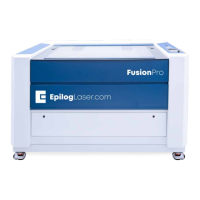
Do you have a question about the Epilog Laser FusionPro 16000 and is the answer not in the manual?
| Laser Type | CO2 |
|---|---|
| Resolution | 1200 dpi |
| Connectivity | Ethernet, USB |
| Engraving Area | 40 x 28 inches (1016 x 711 mm) |
| Laser Power Options | 60W, 75W, 120W |
| Software Compatibility | CorelDRAW, AutoCAD, Adobe Illustrator |
| Maximum Material Thickness | 12.25" (311 mm) |
| Operating Modes | Raster, Vector |
| Motion System | Precision Servo Motors |
| Supported File Formats | AI, DXF, BMP, GIF, JPEG, PNG, TIFF |
| Power Requirements | 220-240 V, 50/60 Hz |
Details laser classification, interlocks, and red dot pointer hazards.
Covers AC input power hazards and safety precautions.
Explains safety enclosure, interlocks, and regulatory labels.
Step-by-step guide for safely removing the laser from its crate.
Details requirements and procedures for exhaust system connection.
Information on power cord, voltage, and circuit requirements.
Instructions for USB and Ethernet connections to the computer.
Procedure for configuring the laser's IP address for network connection.
Overview and installation of the Epilog Job Manager software.
Steps for downloading and installing the main software suite.
Specific installation steps for Ethernet and USB on Windows 8/10.
Common issues and solutions for the Job Manager software.
Initial setup and core functions of the Epilog Job Manager.
Workflow for sending print jobs from graphic software to the Job Manager.
Creating folders, moving files, and managing print jobs.
Saving, importing, and using material and job specific settings.
Configuring CorelDRAW's print driver compatibility settings.
Step-by-step guide for printing a file to the laser.
Tools for positioning artwork accurately on the material.
Methods for splitting jobs into separate engraving or cutting processes.
Explanation of various process settings like Resolution, Speed, and Power.
Understanding the control panel's display, status indicators, and buttons.
Using the joystick for movement, centering, and axis control.
Procedures for manual focus adjustment using the touch screen.
Saving jobs to memory and accessing system configuration menus.
Creating artwork for raster, vector, or combined modes.
Defining vector cutting lines using line width or color.
Guidance on DPI settings for optimal engraving quality.
Choosing document orientation for efficiency and time savings.
Precise artwork placement using the overhead camera.
How Air Assist reduces flare-ups and improves cut quality.
Methods for setting the correct distance between lens and material.
Defining the artwork's center as the primary reference point.
Using print registration marks for accurate artwork alignment.
Using specialized tables for vector cutting jobs.
Instructions for installing and using rotary attachments.
Using both CO2 and Fiber lasers in a single job.
Using PLP software for photo transformation and engraving.
Importance of cleaning to prevent fire hazards and maintain performance.
Procedure for cleaning the laser's optical components for clarity.
Step-by-step guide for replacing the laser lens tube.
Maintenance of exhaust system and laser tube cooling fins.
Overview of the two-step firmware upgrade process.
Instructions for updating firmware using a USB drive.
Instructions for updating firmware using an Ethernet connection.
Information on engraving various materials with a CO2 laser.
Techniques for engraving and cutting acrylic materials.
Methods and settings for working with wood materials.
Techniques for marking metals and plastics with a fiber laser.
Detailed specifications for Fusion Pro models.
Hardware and software recommendations for optimal performance.
Overview of CO2 and Fiber laser source technologies.
Information on how to reach Epilog's technical support team.
Answers to common user queries and troubleshooting tips.
Tips and techniques to optimize job processing times.
Directory of suppliers for various laserable materials.
Details the warranty terms and conditions for the laser system.
Recommended settings for various materials using a CO2 laser.
Recommended settings for various materials using a Fiber laser.
Steps for calibrating the laser's camera system.
Procedure for calibrating the auto focus functionality.
Explanation of various machine settings for calibration.
